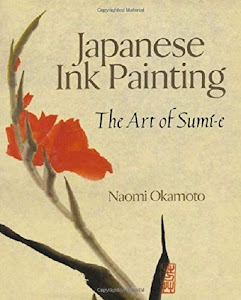
Japanese Ink Painting: The Art of Sumi-E
Catégorie: Romans policiers et polars, Religions et Spiritualités, Bandes dessinées
Auteur: Dian Hanson, David Burns
Éditeur: Paul Ilett
Publié: 2016-06-01
Écrivain: Willard A. Palmer, Michael Teitelbaum
Langue: Japonais, Arabe, Polonais, Espagnol
Format: eBook Kindle, pdf
Auteur: Dian Hanson, David Burns
Éditeur: Paul Ilett
Publié: 2016-06-01
Écrivain: Willard A. Palmer, Michael Teitelbaum
Langue: Japonais, Arabe, Polonais, Espagnol
Format: eBook Kindle, pdf
A Beginner's Guide to Sumi-e: Learn Japanese Ink Painting - Sumi-e is the meditative Japanese form of ink painting taught by Zen Buddhist monks to encourage mindfulness and an awareness of our surroundings. It uses only ink, water, a brush and paper to capture natural objects and landscapes in a vivid, spontaneous fashion. Koike begins with the basics—what to buy and how to prepare the ink in a traditional inkstone. Next, he shows you how to practice
Japanese Art - Looking at the Most Famous Japanese Artists - · He was considered the biggest exponent of Japanese ink wash painting, which was founded by Tenshō Shūbun, his master who taught him Japanese art styles such as Sumi-e (ink wash painting). Portrait of Sesshū Tōyō, c. 16th century; 不詳 unknown , …
Ink wash painting - Wikipedia - Ink wash painting (simplified Chinese: 水墨画; traditional Chinese: 水墨畫; pinyin: shuǐmòhuà; Japanese: 水墨画, romanized: suiboku-ga or Japanese: 墨絵, romanized: sumi-e; Korean: 수묵화, romanized: sumukhwa; Vietnamese: Thủy mặc họa, Hán Nôm: 水墨畫) is a type of Chinese and East Asian ink brush painting which uses black ink, such as that used in Chinese
Oriental Art Supplies for Chinese Brush Painting, and - A family business with 500 years of tradition offering the best Chinese Brush Painting, Japanese Sumi-e and Calligraphy brushes, paper, books, ink, colors and supplies. Also great supplies for Korean and other Asian culture brush arts. Excellent materials offered with fair prices and first class service
Yasutomo – Inspiring Creativity - Our calligraphy markers boast a large ink capacity and a hard felt tip that lasts the life of the pen. The unique mini-chiseled edges comes in three sizes giving you exceptional stroke versatility. Rich black ink. Perfect for calligraphy, sign making, banners, name tags, place cards, certificates, memory albums and journaling. Acid free and non-toxic. Conforms to ASTM D-4326
Japanese painting - Wikipedia - Japanese painting (絵画, kaiga, also gadō 画道) is one of the oldest and most highly refined of the Japanese visual arts, encompassing a wide variety of genres and with the history of Japanese arts in general, the long history of Japanese painting exhibits synthesis and competition between native Japanese aesthetics and the adaptation of imported ideas, mainly from Chinese
Sumi-e: All You Need to Know About Japanese Ink Painting - · Shozo Sato is a renowned master of zen arts, recipient of the Order of the Sacred Treasure, and the author of Sumi-e: The Art of Japanese Ink Painting. His practical and beautifully illustrated guide to sumi-e aims to “take the hand of the student and guide him or her”. To help you get started on your own sumi-e journey, Sato Sensei shares some of his expertise here with helpful
10 Most Famous Japanese Painting Masterpieces | Widewalls - · Editors’ Tip: The Art and Technique of Sumi-e Japanese Ink Painting: Japanese ink painting as taught by Ukao Uchiyama. Japanese painting has an extremely rich history. Throughout the centuries, Japanese artists developed a large number of unique techniques and styles that represent the most valuable Japanese contribution to the world of art. One of these techniques is Sumi-e. Sumi-e
Japanese Art: Everything You Might Not Know - · Zen monks took particularly to ink painting, sumi-e, reflecting the simplicity and importance of empty space central to both art and of the greatest masters of the form, Sesshu Toyo (1420-1506), demonstrates the innovation of Japanese ink painting in View of Ama no Hashidate, by painting a bird’s eye view of Japan’s spectacular coastal landscape
TGx:A Beginner's Guide to Sumi-e - Learn Japanese Ink - · Sumi-e is the meditative Japanese form of ink painting taught by Zen Buddhist monks to encourage mindfulness and an awareness of our surroundings. It uses only ink, water, a brush and paper to capture natural objects and landscapes in a vivid, spontaneous fashion. Koike begins with the basics—what to buy and how to prepare the ink in a traditional inkstone. Next, he shows you how to …
[goodreads], [read], [audiobook], [english], [epub], [audible], [free], [pdf], [download], [kindle], [online]













0 komentar:
Posting Komentar
Catatan: Hanya anggota dari blog ini yang dapat mengirim komentar.